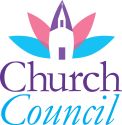Dear Siblings in Christ:
The fact that, in Pentecost is my favorite festival of the Christian calendar. I can relate to being part of a post-resurrection, uncertain, afraid, and mourning people gathering together to try and figure out what’s next. I’ve been part of those groups before. And, I’ve had the honor of being present when there is a palpable shift in the room, and a new idea is born, or the calling of the Spirit catches fire or hope takes root like a thunderbolt.the Book of Acts, everyone also could hear the explanation of what happened in words that made sense to them is one of the most remarkable parts of this story. I love this story. It’s one of possibility, birth, re-birth, and change.
The fact that even after hearing the explanation of what happened, not everyone outside the room understood what happened makes sense, too. The experience transformed those in the room, and those outside the room were witnesses to it. Those who heard the information brought their own experiences, biases, hopes, motivations, and fears to what they heard. Some of those who saw it and were convinced something sacred had happened and others who thought they saw a bunch of drunk people making an early morning raucous. There was more than one way to interpret what was witnessed.
Although certainly not identical, something similar is happening with information about COVID-19. Through the horror, uncertainty, and mourning that has been part of the global experience of the last year and a half, some good news is breaking through. The vaccines are working just a bit better than expected. In the US, infection rates and hospitalization rates are trending in the right direction. Some things that were high-risk behaviors nine months ago are not as high risk now.
Interpreting what this new information means for us is where it gets tricky. Up until now, those people who are brilliant experts in understanding diseases generally agreed on how to stay safe during the pandemic; wash hands, wear a mask, maintain a distance, avoid indoor crowds, limit travel, etc. Even though some particularly loud voices dismissed the importance of these recommendations, the scientific and medical community has been remarkably consistent in its recommendations. Until now.
Take a deep breath, then let it out slowly. Take another deep breath and let that out slowly, too.
Last week, the Centers for Disease Control and Prevention (CDC) made a pretty remarkable announcement. They declared that, based on their interpretation of the scientific data, those who are vaccinated no longer needed to wear a mask indoors or outdoors (except traveling using buses, planes, or travel hubs). This was in line with the progression of increasingly permissive announcements from the CDC over the last several weeks.
Although there was a lot of celebration within the scientific community that came with this announcement, there have also been those who are a lot less confident that this recommendation from the CDC was the right one. Generally speaking, most of these folks are saying something along the line of “Yes, we’re getting safer, but we’re not safe, yet.” Some of these voices have reminded us of the prevalence of virus variances and that there is a real danger that we may be giving vaccine-resistant variances opportunities to take root and spread by not continuing to wear masks. Others have reminded us that there is, as yet, no vaccine that has been approved for those under twelve, and hospitalization rates in that age group - although still statistically small - are increasing.
Understandably, similar conversations are happening in our congregations with some who hear the news from the CDC and are ready to jump back into in-person worship right now. Quite a few others aren’t sure and bring an equally compelling argument to back up their caution. Those with unvaccinated children have additional concerns about how children will be safely included in reopening our church buildings for worship.
Take a deep breath, then let it out slowly. Take another deep breath and let that out slowly, too.
During the beginning days of the pandemic, many of your churches sent out announcements about canceling worship or moving church life online that started with the phrase “Out of an abundance of caution…” My recommendation to you is to continue using this “abundance of caution” as a standard for moving forward.
Personally, this non-scientifically trained clergy person is something like 60% sure that the CDC’s recommendations are safe ones. The State of Washington’s requirements for religious and faith-based gatherings line up pretty closely with these recommendations. Most of what I’m reading says that these recommendations are realistic. However, other voices and opinions either don’t agree or want more time and data to confirm that the CDC’s recommendations are good ones. These voices are equally credible and realistic.
In a lot of cases, “60% sure” is pretty good. In a lot of cases, that might be a risk I’d be willing to take. In good conscience, I could never recommend that someone does something that I think is 60% safe, however—especially when, in this case, the outcome of taking a risk could be so significant. I would never recommend that someone drive a car that I was 60% sure had brakes that worked or walk across ice that I was 60% sure was solid or have surgery with a doctor I was 60% sure was well trained.
At the beginning of the pandemic, it was essential to move quickly, out of an abundance of caution, and find alternatives to gathering in person. As we’re closer to a place where we can manage COVID-19, acting out of an abundance of caution is still the wisest thing to do. At the beginning of the pandemic, I could share a blanket recommendation with all of you. However, at this point, the best I can do is keep encouraging that you act out of an abundance of caution because, when considering reopening, context is everything. Local COVID-19 related numbers, the rate of vaccinations in your congregation, age demographics are the beginning of your considerations. Combine those realities with the ventilation in your church building, and it might mean worshipping outside or continuing to gather online is best for now. For others, that might mean making space for the vaccinated to gather but still wearing masks. Some congregations that meet might sing, and some may not.
The way you relate to each other is also going to be an essential factor. Regardless of how you might move forward, respecting that different folks will have different levels of comfort about gathering will be important for your congregational health. No one should feel pressured into gathering, including your pastor or staff. Having explicit consent is always important but particularly important in moments of transition, crisis, changing relationships, or changing contexts.
As part of that commitment to consent, having clear communication about what the gathering will look like and what will be expected of those attending will be critical. Once gathered, assume no hugs, handshakes, etc., unless someone makes it clear they’re OK with that. Celebrate and honor those who clearly and directly ask as well as those who give a clear “yes” or “no.” All these rules for interacting to be adjusted, lessened, or strengthened along the way. Some will, and should, become long-term expectations. You’ll also have to decide who will be in charge of helping folks follow through. Not every church has ushers or greeters anymore but having empowered ushers to help follow your congregation’s guidelines might be an important part of gathering in person, again.
Take a deep breath, then let it out slowly. Take another deep breath and let that out slowly, too.
Throughout the pandemic, I’ve tried to give you some sort of distillation of all the information I’m reading about COVID-19 and looked for consistent patterns or advice or caution from a wide variety of trusted resources. I’ve tried to set aside the political debates and focus on the health of our congregations and the role the church might have in serving God and God’s people at this moment. I haven’t studied anything this intently, for this long since seminary.
It’s also one of those moments I’m clear that I have a degree from a seminary and not a medical school. From what I’m studying, it truly looks as though it’s not simply the loudest voices suggesting that vaccinated folks can, with a few exceptions, begin to live life as they did before the pandemic but the majority of voices. However, there is a significant minority - including many voices I have come to trust over the last many months - that is saying something along the lines of “Maybe, but not yet.”
I think we’re closer and closer to figuring out a safe way to gather together. I think there’s a good chance that, by sometime in the fall (baring a variant surprise), we’ll have figured something out that will be about as safe as we can get. I also know that the last 10% of any process involving humans takes the longest time and the most resources. That’s where we are right now.
One of the things we’ve learned from each other is how important it is to learn from one another and support each other. Early next week, I’ll share information with you about an upcoming series of conversations where folks can talk about their reopening plans together. There will also be an opportunity for those who have started to gather to talk about what’s working and what’s not.
This Sunday is Pentecost, the day many people call “The Birthday of the Church.” This Sunday, may we celebrate how the Spirit moved so long ago and continues to move today. May the Spirit renew us with the call to serve God and God’s people. May the Spirit renew us with the life found in doing justice, loving kindness, and walking humbly with God.
With hope,
Mike





